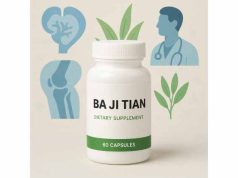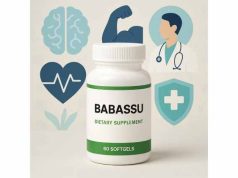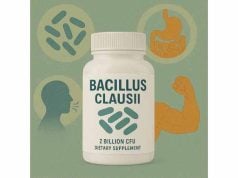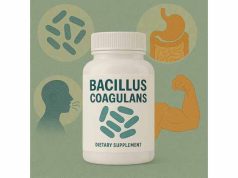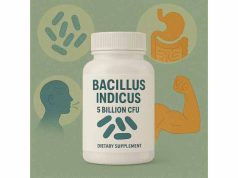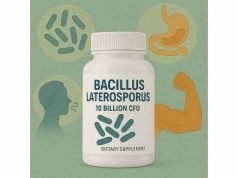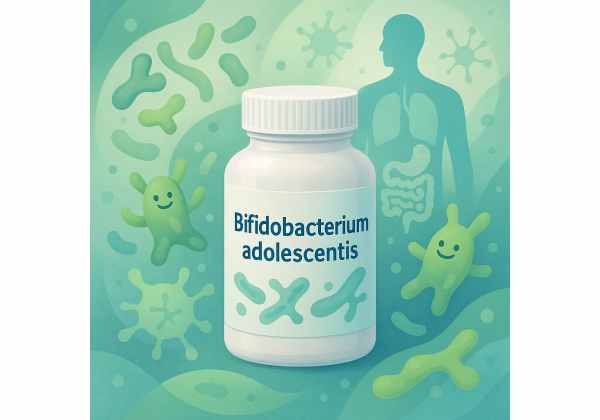
Bifidobacterium adolescentis is a beneficial probiotic bacteria naturally found in the human gut, especially during adolescence and adulthood. Recent research highlights its unique ability to support digestive health, modulate the immune system, and assist with metabolic balance. People turn to B. adolescentis supplements to improve gut microbiome diversity, relieve occasional constipation, and even support mood and brain health through the gut-brain axis. As a naturally occurring probiotic, it is considered safe for most individuals, but understanding its proper use, dosing, and any potential interactions ensures the best results. If you’re looking to optimize your digestive and whole-body wellness, exploring how Bifidobacterium adolescentis works is a great place to start.
Key Takeaways
- Bifidobacterium adolescentis supports healthy digestion, regularity, and a balanced gut microbiome.
- Emerging evidence links this probiotic to improved immune function and reduced inflammation.
- Potential benefits may include relief of constipation, support for metabolic wellness, and positive effects on mood.
- Generally recognized as safe, but those with compromised immunity should consult their healthcare provider before use.
- Supplement forms and dosages vary—choose reputable brands and follow evidence-based guidelines for best results.
Table of Contents
- Bifidobacterium adolescentis Introduction and Key Roles in Human Health
- Biological Mechanisms: How Bifidobacterium adolescentis Supports Digestive and Immune Health
- Clinically Studied Benefits and Evidence-Based Uses of Bifidobacterium adolescentis
- Safety Considerations, Side Effects, and Interactions of Bifidobacterium adolescentis Supplementation
- Recommended Dosage, Usage, Timing, and Administration for Bifidobacterium adolescentis
- Frequently Asked Questions About Bifidobacterium adolescentis
Bifidobacterium adolescentis Introduction and Key Roles in Human Health
Bifidobacterium adolescentis is a species of probiotic bacteria that naturally resides in the human gastrointestinal tract. Probiotics are live microorganisms that, when consumed in adequate amounts, confer health benefits to the host. While many people have heard of probiotics like Lactobacillus or Bifidobacterium lactis, B. adolescentis stands out for its unique contributions to digestive and immune system function—especially during adolescence and adulthood.
What is Bifidobacterium adolescentis?
- It is a non-pathogenic, anaerobic (thrives without oxygen), Gram-positive bacterium belonging to the Bifidobacterium genus.
- First identified in the human intestine, B. adolescentis is now recognized as a core member of the adult gut microbiome.
- This probiotic is commonly found in the colon, where it helps break down complex carbohydrates and produces short-chain fatty acids (SCFAs), including acetate and butyrate, which play key roles in gut health.
How does Bifidobacterium adolescentis differ from other probiotics?
While many probiotics support digestion, B. adolescentis has unique enzymes that enable it to ferment a wide variety of plant fibers and resistant starches. This fermentation helps create a hospitable gut environment, supports the growth of other beneficial bacteria, and limits the expansion of harmful microbes.
Why is Bifidobacterium adolescentis important for health?
- Gut Microbiome Balance: B. adolescentis is considered a “keystone species” for the adult gut, meaning its presence is a strong indicator of a diverse and healthy microbiome.
- Digestive Support: By breaking down otherwise indigestible fibers, this probiotic helps produce nutrients and supports regular bowel movements.
- Immune System Modulation: B. adolescentis influences immune cell activity and helps train the immune system to distinguish between harmful invaders and benign substances, potentially reducing the risk of inflammatory and allergic responses.
- Metabolic Effects: Recent research suggests this probiotic may help regulate blood sugar, cholesterol, and body weight, contributing to metabolic wellness.
- Brain and Mood Connection: Through the gut-brain axis—a communication network between the gut and brain—B. adolescentis may have indirect effects on mood and mental clarity.
Natural Sources and Supplementation
- While naturally occurring in the gut, B. adolescentis populations can decrease with age, antibiotic use, poor diet, or chronic stress.
- Fermented foods like yogurt, kefir, and certain cheeses may contain small amounts, but targeted supplements provide standardized and effective doses for measurable health benefits.
Who Might Benefit from Bifidobacterium adolescentis Supplementation?
- Individuals seeking to optimize digestive regularity and comfort
- Those recovering from antibiotic use or managing mild digestive issues
- Adults interested in immune balance or metabolic health
- People looking for a science-backed probiotic for mood or cognitive support
It’s important to note that individual results vary, and probiotics work best as part of a healthy lifestyle—alongside balanced nutrition, physical activity, and stress management.
Biological Mechanisms: How Bifidobacterium adolescentis Supports Digestive and Immune Health
Understanding the science behind Bifidobacterium adolescentis can help you appreciate why it is considered such a valuable probiotic. Let’s explore the mechanisms that underlie its health benefits.
1. Fiber Fermentation and Short-Chain Fatty Acid (SCFA) Production
B. adolescentis has a unique suite of enzymes that break down complex plant fibers, resistant starches, and prebiotics (special dietary fibers that feed good bacteria). During this fermentation process, the bacterium produces SCFAs, such as acetate, propionate, and butyrate.
- Why it matters: SCFAs are vital fuel for colon cells, help maintain the intestinal barrier, and have anti-inflammatory effects throughout the body.
- Key benefits: Enhanced regularity, improved gut barrier integrity, and better nutrient absorption.
2. Suppression of Harmful Microbes
B. adolescentis competes for space and nutrients, crowding out potentially pathogenic (harmful) bacteria and reducing their ability to colonize the gut. It can also produce substances like bacteriocins—natural antibiotics that inhibit or kill pathogens.
- Why it matters: A balanced gut microbiome lowers the risk of gastrointestinal infections and supports resilience against digestive disturbances.
- Key benefits: Protection against diarrhea, foodborne illness, and gut inflammation.
3. Modulation of the Immune System
This probiotic interacts directly with immune cells lining the gut, helping “train” the immune system for optimal responses. It encourages regulatory T-cell activity, which keeps immune reactions in check and helps prevent chronic inflammation or autoimmunity.
- Why it matters: Gut-associated lymphoid tissue (GALT) is a major component of the immune system, and B. adolescentis plays a key role in its development and function.
- Key benefits: Reduced risk of allergies, better defense against infections, and lower likelihood of chronic inflammatory conditions.
4. Enhancement of Gut-Brain Axis Signaling
B. adolescentis helps produce neurotransmitter precursors and metabolites that influence brain function and mood. For example, certain SCFAs support the synthesis of serotonin, a key “feel-good” chemical.
- Why it matters: A healthier gut environment can translate to improvements in mood, stress resilience, and cognitive performance.
- Key benefits: Potential support for mental clarity and balanced mood.
5. Metabolic Regulation
Through its fermentation activities and immune effects, B. adolescentis can positively impact metabolic health.
- Blood Sugar: It helps slow the absorption of glucose, potentially leading to better glycemic control.
- Cholesterol: Certain SCFAs produced by this bacterium help regulate cholesterol metabolism and may lower LDL (“bad”) cholesterol.
- Body Weight: By influencing satiety hormones and reducing low-grade inflammation, B. adolescentis may play a role in healthy weight management.
Summary of Mechanisms:
- Breaks down difficult-to-digest fibers, producing health-promoting SCFAs
- Outcompetes harmful bacteria for space and nutrients
- Trains and balances the immune system for optimal responses
- Influences neurotransmitter production and mood via the gut-brain axis
- Supports healthy metabolism, including blood sugar and cholesterol levels
These mechanisms work together, making Bifidobacterium adolescentis a highly beneficial member of your gut ecosystem.
Clinically Studied Benefits and Evidence-Based Uses of Bifidobacterium adolescentis
A growing body of clinical research supports the role of Bifidobacterium adolescentis in a variety of health areas. Below, you’ll find the most relevant, evidence-based benefits and how they translate to real-world uses.
1. Promoting Digestive Comfort and Regularity
- B. adolescentis has been shown in studies to help relieve occasional constipation, soften stools, and promote regular bowel movements—especially in adults with mild to moderate digestive complaints.
- Mechanisms include increased SCFA production and improved intestinal motility.
2. Enhancing Gut Microbiome Diversity
- Supplementation with B. adolescentis helps restore gut bacterial diversity, especially after antibiotic use or during times of digestive stress.
- A diverse microbiome is associated with resilience against infections and improved overall gut health.
3. Supporting Immune Function
- Studies show B. adolescentis enhances the activity of certain immune cells (including regulatory T-cells) and decreases markers of inflammation in the gut and body.
- This effect is especially relevant for those prone to allergies, mild inflammatory conditions, or frequent infections.
4. Alleviating Symptoms of Irritable Bowel Syndrome (IBS)
- Some clinical trials indicate that B. adolescentis supplementation reduces bloating, abdominal discomfort, and irregularity in people with IBS.
- This may be due to its anti-inflammatory effects and ability to support the growth of other beneficial bacteria.
5. Potential Role in Metabolic Health
- Early research suggests that regular intake of B. adolescentis can improve markers of blood sugar regulation, cholesterol profiles, and even support weight management.
- These effects are particularly valuable for adults at risk of metabolic syndrome or looking to maintain healthy glucose and lipid levels.
6. Impact on Mood and Cognitive Well-being
- The gut-brain axis connection means that B. adolescentis may indirectly support mood balance, stress resilience, and cognitive clarity.
- Preliminary research links this probiotic with reduced symptoms of low mood and anxiety, likely due to its effects on inflammation and neurotransmitter precursors.
7. Additional Areas of Investigation
- Emerging evidence suggests a possible role for B. adolescentis in skin health, bone density, and hormone balance, though these areas require further study.
Real-World Use Cases
- After Antibiotic Treatment: Restoring healthy bacteria that may have been depleted.
- During Periods of Digestive Distress: Easing symptoms of occasional constipation, bloating, or irregularity.
- For Immune Wellness: Supporting natural defenses, especially during cold and flu season.
- For Healthy Aging: Maintaining gut diversity as the microbiome naturally shifts with age.
Summary Table of Key Benefits
| Health Goal | How B. adolescentis Helps | Evidence Level |
|---|---|---|
| Digestive regularity | Increases SCFA, improves motility | Strong (clinical trials) |
| Microbiome restoration | Replenishes good bacteria after antibiotics | Strong (human studies) |
| Immune modulation | Balances immune response, lowers gut inflammation | Moderate (clinical/lab) |
| IBS symptom relief | Reduces bloating and discomfort | Moderate (clinical trials) |
| Metabolic wellness | Improves blood sugar, cholesterol, weight management | Early (pilot studies) |
| Mood and cognitive support | Influences gut-brain axis and neurotransmitter pathways | Early (pilot studies) |
Takeaway: Bifidobacterium adolescentis is a multi-functional probiotic with strong evidence for digestive and immune health and promising potential for broader wellness benefits.
Safety Considerations, Side Effects, and Interactions of Bifidobacterium adolescentis Supplementation
Bifidobacterium adolescentis is generally recognized as safe for most people, especially when consumed as part of a reputable probiotic supplement or in fermented foods. However, understanding possible side effects, safety considerations for sensitive populations, and potential interactions is essential for responsible use and optimal benefits.
1. General Safety Profile
B. adolescentis is a naturally occurring member of the human gut microbiome. When supplemented in recommended amounts, adverse reactions are rare. Most clinical trials and real-world experience confirm that healthy adults can take this probiotic with a low risk of side effects.
2. Possible Side Effects
Although side effects are uncommon, some individuals may experience mild, short-lived symptoms as the body adjusts, especially in the first few days of probiotic supplementation:
- Mild bloating or gas
- Temporary digestive upset
- Soft stools or increased frequency of bowel movements
These symptoms typically resolve on their own as the gut adapts to the increased presence of beneficial bacteria. If symptoms persist beyond a week or worsen, reducing the dose or discontinuing use is advised.
3. Who Should Use Extra Caution
Certain populations should consult a healthcare provider before taking Bifidobacterium adolescentis:
- Immunocompromised Individuals: People with weakened immune systems (such as those undergoing chemotherapy, living with HIV/AIDS, or using immunosuppressive drugs) may be at a higher risk for rare infections from any probiotic, including B. adolescentis. While serious complications are extremely rare, they are theoretically possible.
- Severe or Critical Illness: Those hospitalized with serious illness or those with central venous catheters should only use probiotics under medical supervision.
- Infants and Young Children: Though some probiotics are specifically formulated for children, dosages and strains should be selected with guidance from a pediatrician.
4. Potential Allergic Reactions
While allergic reactions are very rare, they can occur. Signs include:
- Itching, rash, or hives
- Swelling of the lips, face, or tongue
- Difficulty breathing
If any allergic symptoms appear, discontinue use and seek medical attention immediately.
5. Drug and Supplement Interactions
Bifidobacterium adolescentis is not known to have significant interactions with most medications or supplements. However, a few considerations are important:
- Antibiotics: Antibiotics can reduce the population of probiotics in the gut. If you’re taking antibiotics, consider separating probiotic doses by at least 2 hours to enhance survival and effectiveness.
- Immunosuppressants: As mentioned, caution is advised for those on immunosuppressive therapies. Always consult your healthcare provider before starting any new supplement in these cases.
- Other Probiotics: B. adolescentis is often included in multi-strain probiotic blends and typically works synergistically with other beneficial bacteria. Using more than one product at a time is generally safe, but high doses of multiple probiotics can occasionally increase mild digestive side effects.
6. Quality and Contamination Risks
The safety of Bifidobacterium adolescentis supplements depends on manufacturing quality. Look for brands that offer:
- Third-party testing for purity and potency
- Clear labeling of strain, CFU (colony-forming unit) count, and expiration date
- Proper storage recommendations (some probiotics require refrigeration)
Avoid expired products and those with unclear sourcing to reduce the risk of contamination.
7. Probiotic Jarisch-Herxheimer Response
In some rare cases, introducing a new probiotic may trigger a “die-off” reaction (Jarisch-Herxheimer response), where a temporary worsening of symptoms occurs as harmful bacteria are crowded out. This is usually brief and self-resolving.
8. Signs to Stop Use and Seek Help
Discontinue B. adolescentis supplementation and consult a healthcare professional if you experience:
- Persistent abdominal pain, vomiting, or high fever
- Blood in stool or signs of infection
- Any severe or rapidly worsening symptoms
Summary of Safety Guidelines:
- Bifidobacterium adolescentis is very safe for most adults.
- Start with lower doses to minimize adjustment symptoms.
- Consult your healthcare provider if you are immunocompromised, seriously ill, or giving to a young child.
- Choose reputable, tested products to avoid contamination risks.
Responsible use maximizes the many health benefits this probiotic can provide.
Recommended Dosage, Usage, Timing, and Administration for Bifidobacterium adolescentis
Choosing the right dosage and form of Bifidobacterium adolescentis is key to getting the most benefit with minimal risk of side effects. Dosage recommendations are based on available clinical studies, expert consensus, and manufacturer guidelines.
1. Typical Dosage Ranges
- Adults: Most B. adolescentis supplements provide between 1 billion (1 × 10⁹) and 10 billion (1 × 10¹⁰) CFUs per serving. Effective doses for general digestive health, immune support, and regularity usually fall within this range.
- Children: Some pediatric formulas are available, but dosage should be selected according to product directions and in consultation with a healthcare provider.
2. Choosing the Right Supplement Form
- Capsules/Tablets: The most common and convenient form, usually shelf-stable and easy to take with or without food.
- Powdered Blends: Can be mixed into water, smoothies, or food—ideal for those who have difficulty swallowing pills.
- Multi-Strain Probiotic Formulas: B. adolescentis often appears alongside other beneficial bacteria. These blends may offer synergistic effects for broad-spectrum gut support.
3. Best Timing and Administration
- With or Without Food: Many studies suggest probiotics may survive stomach acid better when taken with meals, but B. adolescentis is resilient enough to be effective either way. If you experience any digestive discomfort, try taking it with food.
- Consistency Matters: For best results, take your probiotic at the same time every day to support steady colonization and maximize benefits.
- After Antibiotics: If recovering from antibiotic treatment, wait until your antibiotic course is complete before starting, or separate doses by at least 2 hours.
4. Duration of Use
- Short-Term: For acute issues (such as after antibiotics or during periods of digestive upset), a 2–4 week course is often sufficient.
- Long-Term: For chronic digestive concerns or ongoing immune/metabolic support, daily use for several months is common and generally safe.
5. How to Increase Effectiveness
- Combine with prebiotic-rich foods (such as onions, garlic, bananas, and asparagus) to help feed and sustain B. adolescentis in the gut.
- Maintain a balanced, fiber-rich diet to further encourage the growth of beneficial bacteria.
6. Storage and Handling
- Follow the storage instructions on your probiotic product. Some strains require refrigeration, while others are shelf-stable.
- Avoid exposure to excessive heat, moisture, or direct sunlight, which can reduce potency.
7. Signs That You May Need to Adjust Your Dosage
- Increase: If no noticeable improvement in digestive comfort, regularity, or overall wellness after several weeks.
- Decrease or Pause: If you experience ongoing digestive upset (bloating, gas, diarrhea), consider lowering your dose or taking a short break.
8. What to Look For in a Quality Supplement
- Strain specificity (should state Bifidobacterium adolescentis and, ideally, a strain number)
- Clearly labeled CFU count and expiration date
- Reputation for product purity and third-party testing
Summary of Administration Tips:
- Adults: 1–10 billion CFUs daily is typical.
- Take with food if sensitive to digestive changes.
- Daily, consistent use is best for sustained benefits.
- Support results with a healthy, fiber-rich diet.
Using Bifidobacterium adolescentis thoughtfully helps ensure you get the maximum benefit from this powerful probiotic.
Frequently Asked Questions About Bifidobacterium adolescentis
What is Bifidobacterium adolescentis used for?
Bifidobacterium adolescentis is used to support digestive regularity, restore gut flora after antibiotics, modulate immune responses, and potentially help with metabolic and mood health through its effects on the gut-brain axis.
Is Bifidobacterium adolescentis safe to take daily?
Yes, daily use of B. adolescentis is generally considered safe for healthy adults. Those with compromised immunity or serious health conditions should check with a healthcare provider before starting supplementation.
How does Bifidobacterium adolescentis benefit the gut?
It breaks down dietary fibers, produces short-chain fatty acids, supports the growth of other beneficial bacteria, and helps protect against harmful microbes, leading to improved gut balance and digestive comfort.
Can Bifidobacterium adolescentis help with constipation?
Yes, clinical studies suggest B. adolescentis can help relieve occasional constipation and promote regular, comfortable bowel movements by increasing fiber fermentation and SCFA production.
Does Bifidobacterium adolescentis interact with medications?
It is not known to cause significant interactions with most medications. However, separate doses from antibiotics by a few hours, and consult your healthcare provider if taking immunosuppressants or if you have serious health concerns.
How long should I take Bifidobacterium adolescentis?
For general wellness or recovery from antibiotics, 2–4 weeks is common. For ongoing digestive or immune support, longer-term daily use is safe for most people.
What foods naturally contain Bifidobacterium adolescentis?
It is naturally present in some fermented foods, such as certain yogurts and cheeses, but supplement forms provide a standardized dose for targeted health benefits.
Disclaimer:
The information provided in this article is for educational and informational purposes only and is not intended as a substitute for professional medical advice, diagnosis, or treatment. Always seek the advice of your physician or another qualified health provider with any questions you may have regarding a medical condition or supplement regimen. Never disregard professional advice or delay in seeking it because of something you have read here.
If you found this article helpful, please consider sharing it with friends and family on Facebook, X (formerly Twitter), or your favorite social media platform. Your support helps us create more high-quality, evidence-based wellness content. Thank you for reading, and don’t forget to follow us for the latest updates and wellness tips!

